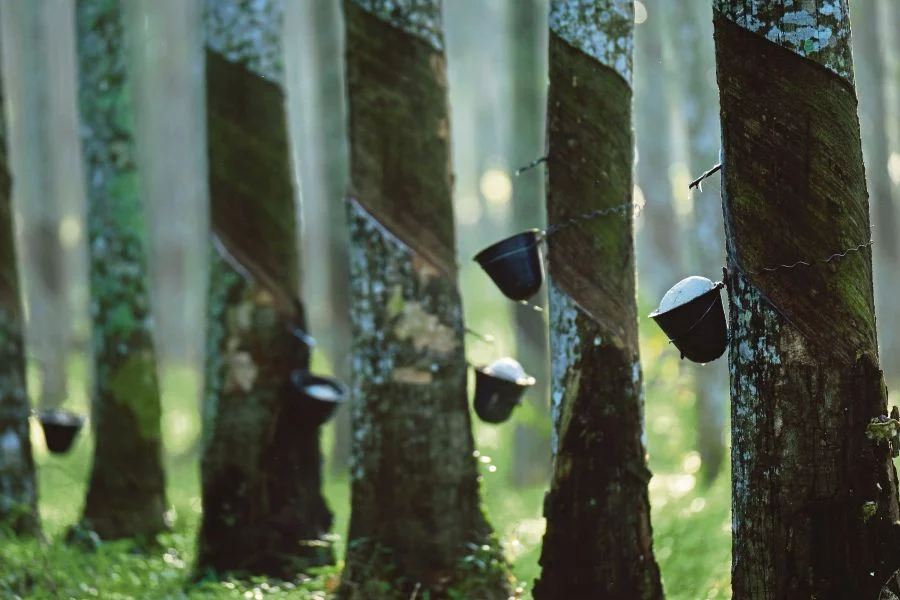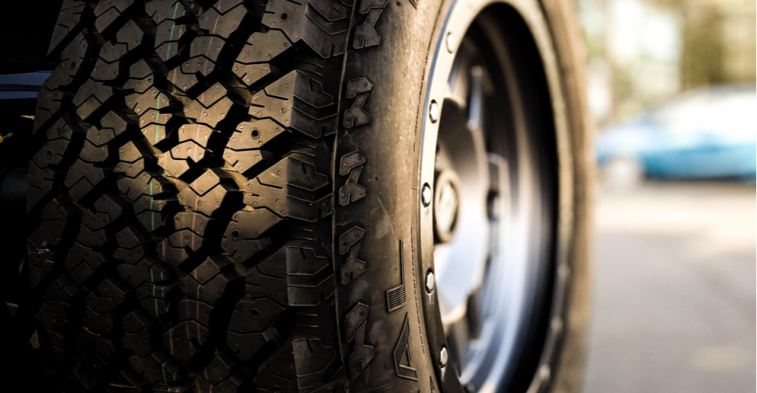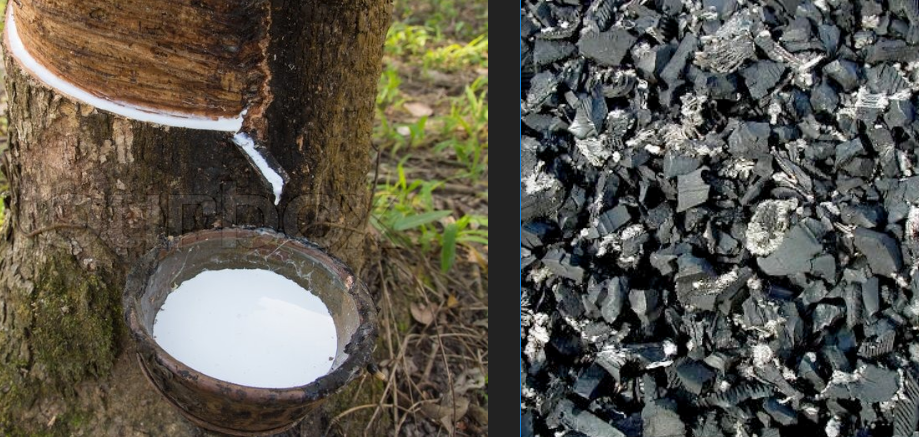What is Natural Rubber?
Natural rubber occurs naturally from tropical plants or rubber trees. The material has loosely connected polymers with excellent elastic properties. On top of it, natural rubber can also be vulcanized to further turn it into usable products. That is because the initial latex sap from the rubber trees isn’t as helpful.
Moreover, a lot of industries use natural rubber. Most products we interact with use natural rubber in one form or another. The most prominent example includes car tires, toys, and medical equipment, among other things.

Even though twenty thousand rubber plants generate latex, only about twenty-five hundred contain rubber. Regardless, the ability of natural rubber to withstand wear and tear and retain shape has made it a marvel for the engineering world. As a result, humans have used this material for thousands of years. Is natural rubber the same as latex? No, they’re not the same. These two terms are used interchangeably, but they’re different. Latex is a general term for any polymers in liquid form. When rubber is produced, natural rubber latex is the milky substance from plants used to make it.
Types of Natural Rubber
Natural rubber, a versatile material essential for numerous applications, is not solely derived from rubber trees. Its various types are based on different plant sources, such as dandelion, rubber fig, and Panama rubber tree. These plants produce latex, which is turned into rubber.
- Hevea Brasiliensis Rubber: The most prevalent type, sourced from the latex of the rubber tree, Hevea brasiliensis. This type dominates the global market, valued for its excellent elasticity and strength.
- Dandelion Rubber: An emerging alternative, derived from the roots of specific dandelion species like the Russian dandelion (Taraxacum kok-saghyz). This rubber is gaining attention as a sustainable option that can thrive in temperate climates.
- Guayule Rubber: Extracted from the Guayule plant, a shrub native to the arid regions of the United States and Mexico. Guayule rubber is considered a promising, eco-friendly alternative to traditional natural rubber.
- Ficus Rubber: Obtained from the latex of certain Ficus trees, such as Ficus elastica. While not as commercially dominant as Hevea rubber, it is still used in some regions.
- Chamaesyce Rubber: Sourced from the latex of plants in the Chamaesyce genus. This type of rubber is a lesser-known alternative, utilized in specific areas.
Each of these natural rubbers possesses unique characteristics and potential uses. The growing interest in sustainable and environmentally friendly rubber sources is leading to increased research and exploration of these alternative types.
Natural Rubber: Properties
Natural rubber has several vital properties that explain its popularity. Humans have used it for many years due to specific material characteristics. The most prominent physical natural rubber properties include the following:

- Environmental Resistance: natural rubber tends to adequately well under outdoor environmental conditions. This includes the ability of rubber to withstand high temperatures, sunlight, and ozone to a certain extent. However, more prolonged or more intense exposure can ruin the material.
- Strength: natural rubber tends to have solid tensile strengths. As a result, any rubber product shows excellent resistance to average wear and tear. Moreover, it can also withstand fatigue longer than many other materials.
- Tear Resistance: the ability of rubber to withstand cuts, chips, and regular tears makes it suitable for so many daily products we use.
- Low Heat Build-up: this means that rubber tends to build up much less heat, especially in dynamic seal applications. As a result, the material has the suitable properties to withstand the stress produced by moving tires on a vehicle.
- Electrical Insulation: the material tends to minimize current passing through it.
- Non-Polar: rubber is a non-polar substance. This allows it to resist many types of acids as well as water. Hence, you will often come across applications with natural rubber sealants.
- Easy Process-ability: rubber has an easy production process. Moreover, since it occurs naturally, manufacturers also find it cost-effective. This, in turn, helps the end user with lower costs and savings in the long run.
Send Your Inquiry Now!
Quality Meets Affordability. Inquire Now for High-Quality Products at Low Volumes.
Natural Rubber: Applications
Given the incredible benefits of natural rubber, it only makes sense to use it for various applications. Below we have listed the most common uses of natural rubber:

- Water Repulsion: natural rubber tends to repel water quite effectively. As a result, many water-related applications use rubber sealants to keep unwanted water out.
- Elasticity: rubber has remarkable elastic properties. As a result, natural has an excellent use for spring applications. This includes the use of rubber in shock absorbers and vibration absorbers.
- Medical: rubber has several uses in the medical industry for multiple applications. This includes medical tubes, surgical equipment, and even condoms. Moreover, natural rubber also creates a barrier against infectious diseases like HIV. Hence, all condoms that we see today are made from rubber latex.
- Vehicles: probably the most common use of rubber by any natural rubber industry. they use it for tires and other components.
- By-products: recently, a by-product of rubber has surfaced with several applications. The by-product rubberwood has excellent inflammable properties. Hence, people can use it for cooking purposes and more.
Natural Rubber: Production Process Explained
Coming to the real deal, how is natural rubber made? Well, we all know rubber comes from the sap of rubber trees. Let’s see how this sap is used to produce the end products.
Step One:
The latex sap from the rubber tree is collected in bowls or tubs. For this, the manufacturer or raw material agent has to create an incision in the tree’s bark.
Step Two:
Rubber in its raw form isn’t handy. Hence, the next step involves refining the raw latex sap to turn it into useful rubber.
Step Three:
The traditional method involved using acid to strengthen the liquid from latex into a more rigid rubber material. This material is like rubber jelly, which is then flattened into sheets and then left to dry. However, over the years, an innovation introduced new ways to refine rubber.

The Natural Rubber Vulcanization Process
In 1839, after many attempts to enhance the elasticity and strength of rubber, Charles Goodyear came up with the vulcanization process. Many scientists have made previous attempts to achieve something similar.
But why? The sole reason is that rubber does not offer good physical properties in its raw form. This includes vulnerability to deformities, breaking in cold conditions, and becoming sticky in hot environments. Hence, the vulcanized rubber resolved all these issues after its discovery. You can learn more about the vulcanization process here.
Send Your Inquiry Now!
Quality Meets Affordability. Inquire Now for High-Quality Products at Low Volumes.
Where does Natural Rubber Come from?
Interestingly, you can find natural rubbers latex in various rubber plants. However, one specific species of rubber plantation is a significant source of natural rubber latex products. The tree goes by the name Hevea Brasiliensis.
Moreover, the tree thrives in specific conditions, such as a relatively average temperature close to 25 degrees Celsius. On top of it, it requires a maximum of 2000mm of rain annually. Furthermore, the tree is most commonly found in Mexico and China, among other countries. Also, the average length of this tree ranges from 500m to 600m from the ground.
Which is Better When It Comes to Natural Rubber Vs. Synthetic Rubber?

Since both are rubbers, they do have some common properties. These include:
- High tear resistance
- Great tensile strength
- Low-temperature flexibility
However, despite the common properties, rubber tends to perform better than synthetic rubber in certain areas. This includes the ability of rubber to withstand more significant pressure than synthetic rubber.
Natural Rubber Advantages:
Moreover, natural rubber also handles everyday wear and tear better than synthetic rubber. On top of it, rubber has a low odor, making it suitable for a broader range of applications, especially in the food and medical industry.
Synthetic Rubber Advantages:
However, despite all this, synthetic rubber also has some areas where it performs better than natural rubber. These include better:
- Ozone resistance
- Electrical resistance
- Chemical resistance
- Fluid resistance
- Heat resistance
Moreover, another drawback of natural rubber compared to synthetic rubber includes allergies to human skin. This occurs because rubber contains natural proteins. Hence, these proteins can cause allergies if they remain in contact with human skin for prolonged periods.
Lastly, while natural and synthetic rubbers have crucial differences and similarities, they are important in our lives. Each material alternates the other where relevant properties of the two are required.
Send Your Inquiry Now!
Quality Meets Affordability. Inquire Now for High-Quality Products at Low Volumes.
Natural Rubber: FAQs
What is a natural rubber example?
The best example of rubber is latex condoms. The latex extract from rubber trees helps create safe and protective condoms and other medical equipment.
What is made out of natural rubber?
Around 70% of the tires that we see on vehicles on the road use rubber. Moreover, other rubber products include shoe soles, balloons, sealants, O-rings, gaskets, grommets, etc.
Why is natural rubber eco-friendly?
Since naturally, rubber comes from trees. The material has biodegradable tendencies. Hence, the environment benefits from the use of rubber as compared to other synthetic rubbers and plastic.
Conclusion
To conclude, natural rubber has made our lives much easier thanks to its properties and uses. On top of it, the vulcanization of rubber makes it suitable for a wide range of applications. The highly in-demand material has been in the natural rubber industry for many years. Moreover, since it occurs naturally, the material will never go out of business.
Looking for a reliable business partner for your natural rubber needs? We have everything if you require rubber gaskets, grommets, or O-rings. At Hongju we use the purest raw materials to ensure consistent product quality.